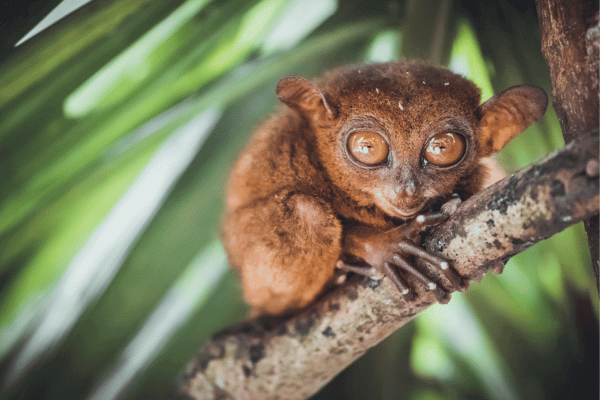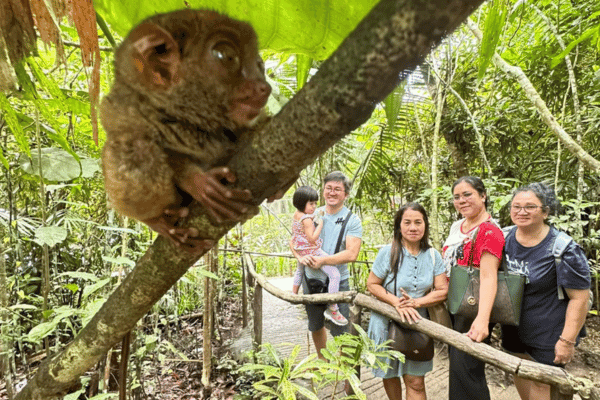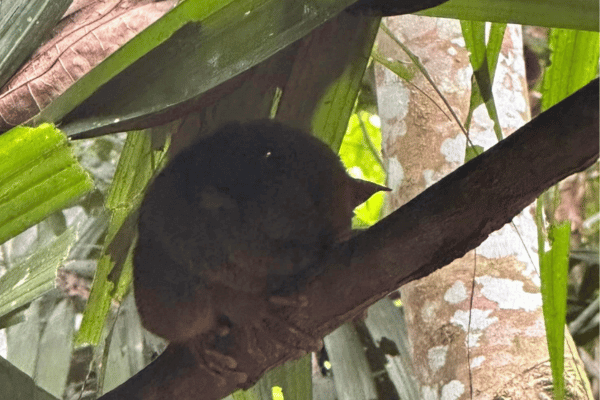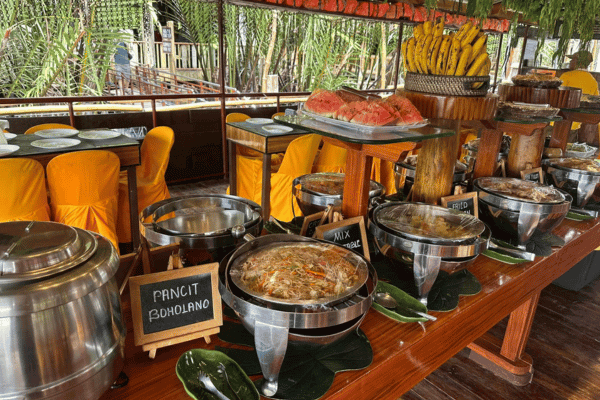The Bohol Tarsier Experience:Visiting the Philippine Tarsier and Wildlife Sanctuary
Ah, Bohol, Philippines! Have you ever noticed how this place is often synonymous with the iconic Philippine tarsier? Picture this: a serene island where the world’s smallest primates play hide and seek amidst lush greenery. Sounds enchanting, right?
The Enigma of the Philippine Tarsier
When I first laid eyes on a tarsier, I was mesmerized. These primates, known by various names across the islands of Bohol, Samar, Leyte, and Mindanao, have a mysterious aura. With their huge eyes that can turn almost 180 degrees and a stature claiming the title of one of the world’s smallest primates, they’re truly a wonder of nature.

Philippine Tarsier vs. Other Species
While the Philippine tarsier is the most famous, there are other tarsier species found in Southeast Asia. Here’s a quick comparison to help you understand the unique characteristics of each:
| Species | Size | Habitat | Specific Locations/Islands | Diet | Conservation Status |
|---|---|---|---|---|---|
| Philippine Tarsier (Tarsius syrichta) | 85-160 mm | Forests | Bohol, Leyte, Samar, and Mindanao in the Philippines | Insects, small vertebrates | Near Threatened |
| Spectral Tarsier (Tarsius tarsier) | 90-140 mm | Forests | Islands of Sulawesi in Indonesia | Insects, birds, bats | Least Concern |
| Western Tarsier (Tarsius bancanus) | 110-150 mm | Forests | Borneo, Sumatra, and nearby islands in Indonesia and Malaysia | Insects, small vertebrates | Data Deficient |
The table above provides a snapshot of how the Philippine tarsier compares to its cousins. Each species has its unique characteristics and challenges, but they all share the need for conservation and protection.
Bohol’s Tarsier Sanctuaries
The Philippine Tarsier and Wildlife Sanctuary in Corella is the crown jewel of Bohol’s conservation efforts, and one of the top tourist spots in Bohol. Spanning an area in the town of Corella, a short drive from Tagbilaran City, this sanctuary is a haven for the world’s smallest primates. The sanctuary, managed by the Philippine Tarsier Foundation, is dedicated to the preservation and research of tarsiers. Here, in the woods of Bohol Island, these primates live in a semi-natural habitat, safe from predators and deforestation. Visitors can take a guided tour, walking along forest trails to spot tarsiers in their natural environment. But remember, these creatures are nocturnal, so spotting them during the day might require a keen eye!
Not too far away is the Loboc Tarsier Conservation Area. Located near the Loboc River, this area offers another glimpse into the world of tarsiers. While it’s smaller than the sanctuary in Corella, it’s equally committed to the cause. The tarsiers here are known to be a bit more elusive, making the experience all the more rewarding when you finally spot one clinging to a branch or staring back with those massive eyes.
Both sanctuaries emphasize the importance of responsible tourism. Flash photography is prohibited, as it can distress the tarsiers. And while it might be tempting to get up close, visitors are advised to maintain a respectful distance. After all, the tarsiers in Bohol are not just tourist attractions; they’re a testament to the island’s dedication to preserving its natural wonders.
Conservation Efforts in Bohol
Bohol isn’t just a picturesque island in the Philippines; it’s a beacon of hope for wildlife conservation, particularly for the endangered Philippine tarsier. Over the years, the island has witnessed a surge in efforts to protect these tiny primates, ensuring they thrive for generations to come.
The Philippine Tarsier Foundation, a non-profit organization, has been at the forefront of these efforts. Established in the town of Corella, the foundation has dedicated itself to the research, breeding, and conservation of tarsiers. Their mission? To ensure that the tarsiers, once a common sight in the southern parts of Bohol, remain a symbol of the island’s rich biodiversity.
But why the emphasis on tarsiers? These creatures, often referred to as the world’s smallest primates, are on the brink of endangerment. Factors like deforestation, hunting, and even the pet trade have threatened their existence. In response, the Philippine Tarsier and Wildlife Sanctuary was established as a safe haven. Covering an expansive area in Corella, this sanctuary ensures that tarsiers live in a protected environment, replicating their natural habitat.
Conservation isn’t just about protection; it’s about education too. Both the sanctuary in Corella and the Loboc Tarsier Conservation Area have educational centers. Visitors can learn about the nature of tarsiers, their unique behaviors, and the challenges they face. Interactive exhibits, guided tours, and even workshops emphasize the importance of coexisting with nature.
Bohol’s commitment doesn’t end with tarsiers. The island’s conservation blueprint extends to other areas too. From the mangroves of Panglao Island to the marine sanctuaries around Alona Beach, Bohol is a testament to what dedicated conservation efforts can achieve. And as visitors, our role is simple: respect, appreciate, and support these endeavors.
Experiencing the Tarsiers: How and When to Visit
Visiting the tarsier sanctuaries in Bohol is a unique experience, one that requires a bit of planning to ensure you get the most out of your trip. Here’s a detailed guide on what to expect and how to prepare:

Best Time to Visit
Tarsiers are nocturnal creatures, which means they’re most active at night. However, during the day, especially in the early morning or late afternoon, you can catch them resting with their huge eyes wide open. To avoid the crowds and enjoy a more intimate experience, consider visiting on weekdays and arriving early, right when the sanctuary opens.
What to Wear
Comfort is key. The sanctuaries are located in forested areas, so it’s advisable to wear:
- Light, breathable clothing: Think cotton t-shirts and comfortable pants or shorts.
- Sturdy footwear: Walking shoes or sandals with straps are ideal as you might be walking on uneven paths.
- Hat and sunglasses: Protect yourself from the tropical sun.
What to Bring
Travel light but don’t forget the essentials:
- Water bottle: Stay hydrated, a bottle of water can be expensive in some areas.
- Camera: Capture the beauty of these tiny primates, but remember to turn off the flash.
- Binoculars: Get a closer look without disturbing the tarsiers.
- Small backpack: To keep your hands free while walking. I have a small slingbag for my wallet and cellphone.
- Insect repellent: Protect yourself from mosquito bites. I would add this especially if you have a kid, like me. Although, we’ve never experienced getting bit by any kind of insect, it’s much better to be safe.
What to Expect
Respect is paramount. Tarsiers are sensitive creatures, and the sanctuaries are their home. Here’s what to keep in mind:

- Quiet Please: Tarsiers can get stressed easily. Maintain silence and avoid making sudden movements.
- No Flash Photography: Bright lights can harm tarsiers. Always turn off the flash when taking photos. It’s been known that tarsiers who are stressed out for not getting enough rest sometimes commit suicide.
- Stay on Marked Paths: This is both for your safety and to protect the tarsiers’ habitat.
- Guided Tours: Some sanctuaries offer guided tours. Guides are knowledgeable and can provide insights about tarsiers and their conservation.
Entrance Fees and Other Details
The entrance fee to the sanctuary is Php 60 (or $ 1.1). This fee goes towards the conservation efforts of the sanctuary, ensuring that these unique creatures and their habitat are preserved for future generations.
The sanctuary is open from 9:00 AM to 4:00 PM. The tarsiers are nocturnal creatures, so visiting during the sanctuary’s opening hours ensures you’ll see them during their resting period. This means they’ll be more stationary and easier to spot. However, remember they’ll mostly be sleeping, so keep your voices down and movements slow to avoid disturbing them.
In my experience, visiting the tarsier sanctuaries in Bohol is a once-in-a-lifetime opportunity. The sheer wonder of seeing these tiny primates up close, in their natural habitat, is truly unforgettable. Just remember to be respectful, and you’ll have an enriching experience that you’ll cherish for years to come.
Tourist Spots Near the Tarsier Sanctuaries
While the tarsiers are the crown jewels of Bohol, the areas surrounding the sanctuaries are brimming with natural wonders and unique attractions. If you’re venturing to see the tarsiers, here are some nearby spots you shouldn’t miss:
Chocolate Hills
Just a short drive from the tarsier sanctuaries, the Chocolate Hills are a geological marvel. These 1,200+ symmetrical mounds turn a cocoa brown during the dry season, offering a panoramic view that’s nothing short of breathtaking.
Loboc River
Near the Loboc Tarsier Conservation Area, the Loboc River offers a serene escape. Cruising on its calm waters aboard a floating restaurant while being serenaded by local musicians is a rejuvenating experience. The lush green banks and the cool breeze make it a perfect spot after a day of tarsier spotting.
Man-Made Forest
Bohol’s commitment to the environment is evident in the Bilar Man-Made Forest, a 2-kilometer stretch of densely planted mahogany trees. As you traverse this forest, the temperature drops, and you’re enveloped by the towering trees. It’s a refreshing detour, especially if you’re traveling between the Chocolate Hills and the tarsier sanctuary.
Lemur and Butterfly Park
Close to the tarsier sanctuaries, this park offers a chance to see playful lemurs and a variety of colorful butterflies. While lemurs are not native to the Philippines, they’ve found a safe haven here. The butterfly garden within the park is a treat for nature lovers, showcasing various butterfly species in a vibrant setting.
Bohol is a mosaic of natural wonders, and the areas around the tarsier sanctuaries are no exception. Each spot, whether it’s the silent majesty of the Chocolate Hills or the playful antics of lemurs, adds to the rich tapestry of experiences that the island offers. So, when in Bohol, wander, explore, and let nature’s wonders enchant you!
Local Delicacies and Dining Near the Sanctuaries
Bohol isn’t just about tarsiers and natural wonders; it’s also a haven for food enthusiasts. The province offers a rich culinary heritage, with dishes that are a delightful mix of traditional Filipino flavors and Boholano creativity. If you’re visiting the tarsier sanctuaries, here are some local delicacies and dining options to indulge in:

Boholano Specialties to Try
- Peanut Kisses: Inspired by the iconic Chocolate Hills, these are small, hill-shaped treats made from peanuts and egg whites. They’re sweet, crunchy, and perfect as a snack or souvenir.
- Kalamay: A sticky and sweet delicacy made from glutinous rice, coconut milk, and brown sugar, often served in a coconut shell.
- Binagol: A sweet treat made from taro root, coconut, and peanuts, usually packed in a coconut shell.
- Ube Halaya: A rich and creamy dessert made from purple yam, condensed milk, and butter.
Dining Options Near the Sanctuaries
While the areas around the tarsier sanctuaries are more serene and less commercialized, there are still some dining gems to be discovered:
- Loboc River Cruise: Combine sightseeing with dining as you cruise along the Loboc River. Enjoy a buffet spread of local dishes as you’re serenaded by local performers.
- Local Carinderias: These are small eateries offering home-cooked Boholano dishes. They’re a great place to experience authentic local flavors at affordable prices.
- Farm-to-Table Restaurants: With Bohol’s rich agricultural heritage, some restaurants offer fresh, organic dishes sourced directly from local farms.
In my experience, dining in Bohol is as much a journey of discovery as exploring its natural wonders. Each dish tells a story of the island’s rich history, culture, and the warmth of its people. So, after marveling at the tarsiers, treat your taste buds to the delightful flavors of Bohol!
Accommodations in Bohol: Where to Stay
After a day of exploring and marveling at the tarsiers, you’ll need a comfortable place to rest and recharge. While Bohol offers a wide range of accommodations, staying near the tarsier sanctuaries offers the advantage of proximity and the serenity of nature. Here’s a guide to accommodations near the sanctuaries:
Resorts and Hotels
For those looking for a touch of luxury and all the modern amenities, there are several resorts and hotels near the sanctuaries:
- Loboc River Resort: Nestled along the Loboc River, this resort offers a tranquil environment with nipa hut-style accommodations. It’s a blend of nature and comfort, with the river providing a serene backdrop.
- Nuts Huts: A favorite among backpackers, Nuts Huts offers simple accommodations in a lush, forested setting. It’s close to both the tarsier sanctuary and the Loboc River.
Bed and Breakfasts
For a more intimate and homey experience, consider staying at one of the local bed and breakfasts:
- Stefanie Grace Paradise Inn: Located in Loboc, this inn offers cozy rooms and a friendly atmosphere. It’s a short drive from the tarsier sanctuary and other local attractions.
- Water to Forest Ecolodge: A peaceful retreat surrounded by nature, this ecolodge is close to the sanctuary and offers eco-friendly accommodations.
One time we visited Bohol, we stayed at a quaint bed and breakfast near the sanctuary, I forget the name of the place at the moment. Waking up to the sounds of nature, enjoying a local breakfast, and being just minutes away from the tarsiers was an experience I’ll never forget. Whether you’re looking for luxury, a budget-friendly option, or a cultural experience, Bohol has accommodations to suit every traveler’s needs. Just remember to book in advance, especially during peak tourist seasons!
Transportation and Routes
Whether you’re starting from Panglao’s beaches or Tagbilaran’s city center, reaching the tarsier sanctuaries is a scenic journey. Here’s a guide on the best routes and transportation options:
Transportation Options
- By Car or Motorbike: Renting gives you the freedom to explore at your pace. From either starting point, head towards the Loay Interior Road. If you’re coming from Panglao, you’ll pass through Tagbilaran first.
- By Tour or Shuttle: Tour operators in both Panglao and Tagbilaran offer trips to the sanctuaries, often combined with other attractions.
- By Public Transport: Head to Tagbilaran’s Dao Bus Terminal from either location. Buses and vans headed towards Carmen or Bilar pass by the sanctuaries. Inform the driver of your destination.
The journey to the tarsier sanctuaries offers picturesque views of Bohol’s countryside. Whichever mode of transport you choose, the enchanting tarsiers await your visit.
Travel Time Estimates
| Mode of Transport | From Panglao | From Tagbilaran |
|---|---|---|
| Car or Motorbike | 1.5 to 2 hours | 45 minutes to 1 hour |
| Public Transport | 2 to 2.5 hours (including waiting time) | 1 to 1.5 hours (including waiting time) |
The Philippine tarsier is more than just an iconic symbol of Bohol, it’s a testament to the rich biodiversity of the Philippines. These tiny primates, with their mesmerizing eyes and nocturnal habits, captivate the hearts of everyone who visits. The tarsier sanctuaries in Bohol play a pivotal role in ensuring that future generations can also experience the magic of these creatures.
By visiting the sanctuaries, not only do you get a chance to witness these unique animals in their natural habitat, but you also contribute to their conservation and the preservation of their environment. As you leave the sanctuary, with memories of those big, curious eyes looking up at you, it’s a gentle reminder of the delicate balance of nature and our role in its preservation. Bohol offers a blend of natural beauty, cultural richness, and culinary delights, but the true essence of the island lies in its commitment to safeguarding its most treasured inhabitants, the tarsiers.